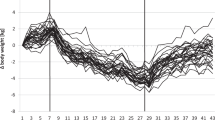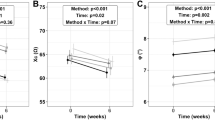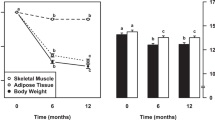Abstract
Objective:
To examine the effect of acute fluid consumption on measures of impedance and percent body fat (%BF) using a common leg-to-leg bioelectrical impedance analyzer system.
Design:
Cross-sectional design with treatment order determined using a counterbalanced assignment.
Setting:
University laboratory.
Subjects:
In total, 21 recreationally active men (mean age 19.7±1.0 years; body mass index 24.2±2.3 kg/m2) volunteered to participate in this study.
Intervention:
Subjects had their body composition assessed on three separate occasions. After an initial baseline body composition measurement, subjects consumed 591 ml of water (H2O), a carbohydrate/electrolyte drink (CHOE), or received nothing, used as the control (CON). Subjects were reassessed 20, 40, and 60 min after baseline (POST). Urine specific gravity (USG) was recorded at baseline and 60 min POST to assess hydration state.
Results:
There were no significant changes in impedance or total body water (TBW) for any of the measurement time periods after drinking H2O or a CHOE beverage. Body weight (BW) (P<0.0001) and %BF (P<0.02) increased significantly 20 min POST and remained elevated at the 40 and 60 min POST time periods. After drinking, USG significantly decreased (P<0.0001) 60 min POST from baseline. For the CON trial, there were no significant changes in BW, %BF, TBW, or USG over time.
Conclusions:
Fluid consumption had no effect on lower-body impedance despite causing significant changes in hydration state. A slight overestimation in %BF (∼0.5%) was observed due to increased BW in the H2O and CHOE trials. This finding may have little practical significance when assessing body composition by LBIA.
This is a preview of subscription content, access via your institution
Access options
Subscribe to this journal
Receive 12 print issues and online access
$259.00 per year
only $21.58 per issue
Buy this article
- Purchase on Springer Link
- Instant access to full article PDF
Prices may be subject to local taxes which are calculated during checkout



Similar content being viewed by others
References
American College of Sports Medicine (ACSM) (1996). Position stand on weight loss in wrestlers. Med Sci Sports Exerc 28, ix–xii.
Bartok C, Schoeller DA, Sullivan JC, Clark RR, Landry GL (2004). The effect of dehydration on wrestling minimum weight assessment. Med Sci Sports Exerc 36, 160–167.
COMMITTEE NWR (1988). 1998–99 Wrestling Weight Certification Program. Indianapolis, IN: NCAA Publications. pp. 1–18.
Deurenberg P, Weststrate JA, Paymans I, van der Kooy K (1988). Factors affecting bioelectrical impedance measurement in humans. Eur J Clin Nutr 42, 1017–1022.
Dixon CB, Deitrick RW, Pierce JR, Cutrufello PT, Drapeau LL (2005). Evaluation of the BOD POD and leg-to-leg BIA for estimating percent body fat in National Collegiate Athletic Association Division III collegiate wrestlers. J Strength Cond Res 19, 85–91.
Elsen R, Siu ML, Pineda O, Solomons NW (1987). Sources of variability in bioelectrical impedance determinations in adults. In: Ellis KJ, Yasumura S and Morgan WD (eds). In vivo Body Composition Studies. Institute of Physical Sciences in Medicine: London. pp 184–188.
Gomez T, Mole PA, Collins A (1993). Dilution of body fluid electrolytes affects bioelectrical impedance measurements. Sports Med Training Rehab 4, 291–298.
Heyward VH, Wagner DR (2004). Applied Body Composition Assessment. Champaign, IL: Human Kinetics. pp. 87–98.
Jackson AS, Pollock ML, Graves JE, Mahar MT (1988). Reliability and validity of bioelectrical impedance in determining body composition. J Appl Physiol 64, 529–534.
Kushner RF, Gudivaka R, Schoeller DA (1996). Clinical characteristics influencing bioelectrical impedance analysis measurements. Am J Clin Nutr 64 (Supp l), 423S–427S.
National Institutes of Health Technology Assessment Conference (NIHTAC) (1996). Bioelectrial impedance analysis in body composition measurement. Am J Clin Nutr 64 (Supp l), 524S–532S.
Nunez C, Gallagher D, Visser M, Pi-Sunyer FX, Wang Z, Heymsfield SB (1997). Bioimpedance analysis: evaluation of leg-to-leg system based on pressure contact foot-pad electrodes. Med Sci Sports Exerc 29, 524–531.
Shirreffs SM (2003). Markers of hydration status. Eur J Clin Nutr 57 (Suppl 2), S6–S9.
Acknowledgements
We gratefully acknowledge all subjects for their participation in this investigation.
Author information
Authors and Affiliations
Corresponding author
Additional information
Guarantor: CB Dixon.
Contributors: CBD was responsible for study design, data analysis, and writing of the manuscript. SJL assisted with study design and was responsible for data collection. JLA and FLG provided significant advice regarding data analysis and were responsible for revision of the manuscript.
Rights and permissions
About this article
Cite this article
Dixon, C., LoVallo, S., Andreacci, J. et al. The effect of acute fluid consumption on measures of impedance and percent body fat using leg-to-leg bioelectrical impedance analysis. Eur J Clin Nutr 60, 142–146 (2006). https://doi.org/10.1038/sj.ejcn.1602282
Received:
Revised:
Accepted:
Published:
Issue Date:
DOI: https://doi.org/10.1038/sj.ejcn.1602282
Keywords
This article is cited by
-
Letter to the Editor concerning “The association of back muscle strength and sarcopenia-related parameters in the patients with spinal disorders” by Toyoda H, et al. (Eur Spine J; https://doi.org/10.1007/s00586-018-5858-8)
European Spine Journal (2019)
-
Influence of acute consumption of caffeine vs. placebo over Bia-derived measurements of body composition: a randomized, double-blind, crossover design
Journal of the International Society of Sports Nutrition (2018)
-
The effect of a meal on measures of impedance and percent body fat estimated using contact-electrode bioelectrical impedance technology
European Journal of Clinical Nutrition (2013)
-
The effect of acute fluid consumption on measures of impedance and percent body fat estimated using segmental bioelectrical impedance analysis
European Journal of Clinical Nutrition (2009)



